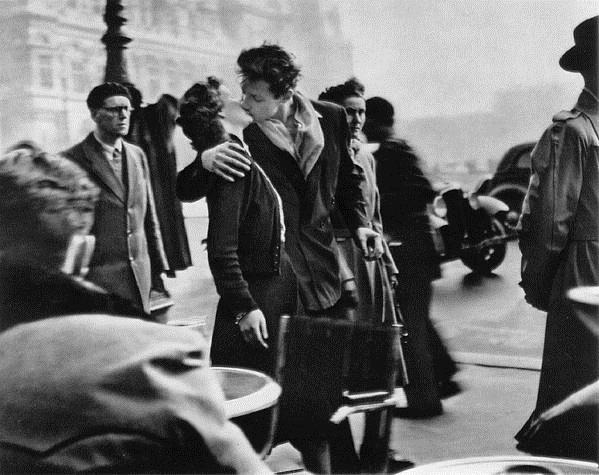La pose y el beso, 67 años después!
En honor a mi admirable amor virtual, Cecilia Raquel Chirveches C. --Un erotómano enamorado (un poco tarde para el día del beso, pero en fin...)
Le baiser de l'hôtel de ville (The Kiss)In 1950 Doisneau created his most recognizable work for Life – Le baiser de l'hôtel de ville (Kiss by the Hôtel de Ville), a photograph of a couple kissing in the busy streets of Paris,[7]
which became an internationally recognised symbol of young love in
Paris. The identity of the couple remained a mystery until 1992.[8]
Jean and Denise Lavergne erroneously believed themselves to be the couple in The Kiss,
and when Robert and Annette Doisneau (his older daughter and also his
assistant at the time) met them for lunch in the 1980s he "did not want
to shatter their dream" so he said nothing. This resulted in them taking
him to court for "taking their picture without their knowledge",
because under French law an individual owns the rights to their own
likeness. The court action forced Doisneau to reveal that he posed the
shot using Françoise Delbart and Jacques Carteaud, lovers whom he had
just seen kissing, but had not photographed initially because of his
natural reserve; he approached them and asked if they would repeat the
kiss. He won the court case against the Lavergnes.[1][3][9][10]
Doisneau said in 1992, "I would never have dared to photograph people
like that. Lovers kissing in the street, those couples are rarely
legitimate."[8][9]
The couple in Le baiser were Françoise Delbart, 20, and
Jacques Carteaud, 23, both aspiring actors. In 2005 Françoise Bornet
(née Delbart) stated that,
"He told us we were charming, and asked if we
could kiss again for the camera. We didn't mind. We were used to
kissing. We were doing it all the time then, it was delicious. Monsieur
Doisneau was adorable, very low key, very relaxed." They posed at the Place de la Concorde, the Rue de Rivoli and finally the Hôtel de Ville.
The photograph was published in 12 June 1950, issue of Life.[10]
The relationship between Delbart and Carteaud only lasted for nine months.[9]
Delbart continued her acting career, but Carteaud gave up acting to become a wine producer.
In 1950 Françoise Bornet was given an original print of the
photograph, bearing Doisneau's signature and stamp, as part of the
payment for her "work". In April 2005 she sold the print at auction for €155,000 to an unidentified Swiss collector via the Paris auctioneers Artcurial Briest-Poulain-Le Fur.
Robert_Doisneau (En español)
"The photo was posed. But the kiss was real."
La foto fue en pose. Pero el beso fue real.
lineassobrearte.com/2017/03/09/robert-doisneau-fotos-de-vida-amor-y-guerra/
lunes, 1 de mayo de 2017
Suscribirse a:
Entradas (Atom)


